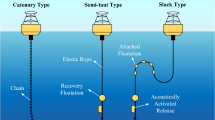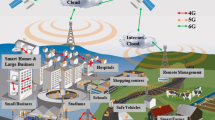Abstract
The scientific and technological revolution in Internet of Things is set off in oceanography. Humans have always observed the ocean outside the ocean to study the ocean. In recent years, it changes have been made into the interior of the ocean and the laboratories have been built on the sea floor. Approximately 71% of the Earth’s surface is covered by water. Ocean of things is expected to be important for disaster prevention, ocean resource exploration, and underwater environmental monitoring. Different from traditional wireless sensor networks, ocean of things has its own unique features, such as low reliability and narrow bandwidth. These features may be great challenges for ocean of things. Furthermore, the integration of artificial intelligence and ocean of things has become a topic of increasing interests for oceanology research fields. Cognitive ocean of things (COT) will become the mainstream of future ocean science and engineering development. In this paper, we provide the definition of COT, and the main contributions of this paper are (1) we review the ocean observing networks all the world; (2) we propose the COT architecture and describe the details of it; (3) important and useful applications are discussed; (4) we point out the future trends of COT researches.




Similar content being viewed by others
References
Industry 4.0: The fourth industrial revolution. https://www.i-scoop.eu/industry-4-0/.
Arrott, M., Chave, A., & Farcas, C. (2011). Building transparent data access for ocean observatories: Coordination of US IOOS DMAC with NSFs OOI cyberinfrastructure. In OCEANS (pp. 1–9).
Suyehiro, K., Mikada, H., & Asakwawa, K. (2003). Japanese seafloor observing systems: Present and future. Marine Technology Society Journal, 37(3), 102–114.
Person, R., Favali, P., & Ruhl, H. (2015). ESONET multidisciplinary scientific community to EMSO novel European research infrastructure for ocean observing. In R. Person (Ed.), Seafloor observatories: A new vision of the earth from the abyss (pp. 531–564). Berlin: Springer.
Barnes, C., Best, M., & Johnson, F. (2013). Challenges, benefits, and opportunities in installing and operating cabled ocean observatories: Perspectives from NEPTUNE Canada. IEEE Journal of Oceanic Engineering, 38(1), 144–157.
Moloney, J., Hillis, C., Mouy, X., Urazghildiiev, I., & Dakin, T. (2014). Autonomous multichannel acoustic recorders on the VENUS ocean observatory. In Proceedings of the of IEEE oceans (pp. 1–6).
Kaneda, Y. (2010). The advanced ocean floor real time monitoring system for mega thrust earthquakes and tsunamis-application of DONET and DONET2 data to seismological research and disaster mitigation. In Proceedings of IEEE oceans (pp. 1–6).
Shim, J., Lee, D., & Kim, S. (2009). Application of a large ocean observation buoy in the middle area of the Yellow Sea. Ocean and Polar Research, 31(4), 401–414.
Lewis, P. Internet of Things. http://www.duluthenergydesign.com/Content/Documents/GeneralInfo/PresentationMaterials/2017/Day2/Internet-of-Things-LaForge.pdf. Accessed 2017.
Domingo, M. (2012). An overview of the internet of underwater things. Journal of Network and Computer Applications, 35, 1879–1890.
Demirors, E., Sklivanitis, G., Melodia, T., Batalama, S., & Pados, D. (2015). Software-defined underwater acoustic networks: Toward a high-rate real-time reconfigurable modem. IEEE Communications Magazine, 53(11), 64–71.
Kaushal, H., & Kaddoum, G. (2016). Underwater optical wireless communication. IEEE Access, 4, 1518–1547.
Mandić, F., Rendulić, I., Mišković, N., & Nađ, Đ. (2016). Underwater object tracking using sonar and USBL measurements. Journal of Sensors. https://doi.org/10.1155/2016/8070286.
Xie, S., Chen, J., Luo, J., Xie, P., & Tang, W. (2012). Detection and tracking of underwater object based on forward-scan sonar. In Proceedings of the international conference on intelligent robotics and applications (pp. 341–347).
Li, M., Ji, H., Wang, X., Weng, L., & Gong, Z. (2013). Underwater object detection and tracking based on multi-beam sonar image processing. In Proceedings of IEEE international conference on robotics and biomimetics (pp. 1–5).
Snyder, J., Silverman, Y., Bai, Y., & Maclver, M. (2013). Underwater object tracking using electrical impedance tomography. In: Proceedings of the IEEE/RSJ international conference on intelligent robots and systems (pp. 1–6).
Walther, D., Edgington, D., & Koch, C. (2004). Detection and tracking of objects in underwater video. In Proceedings of the 2004 computer society conference on computer vision and pattern recognition (pp. 1–5).
Chuang, M., Hwang, J., Ye, J., Huang, S., & Williams, K. (2016). Underwater fish tracking for moving cameras based on deformable multiple kernels. arXiv:1603.01695.
Lee, D., Kim, G., Kim, D., Myung, H., & Choi, H. (2012). Vision-based object detection and tracking for autonomous navigation of underwater robots. Ocean Engineering, 48, 59–68.
IHI. (2014). Power generation using the Kuroshio current. IHI Engineering Review, 46(2), 1–5.
Pattle, R. (1954). Production of electric power by mixing fresh and salt water in the hydroelectric pile. Nature, 174(4431), 660.
Mitra, U., Choudhary, S., Hover, F., Hummel, R., Kumar, N., Naryanan, S., et al. (2015). Structured sparse methods for active ocean observation systems with communication constraints. IEEE Communications Magazine, 53(11), 88–96.
Ghassemlooy, Z., Zvanovec, S., Khalighi, M., Popoola, W., & Perze, J. (2017). Optical wireless communication systems. Optik, 151, 1–6.
Han, G., Jiang, J., Shu, L., Xu, Y., & Wang, F. (2012). Localization algorithms of underwater wireless sensor networks. Sensors, 12(2), 2026–2061.
Chandrasekhar, V., Seah, W. K., Choo, Y. S., & Ee, H. V. (2006). Localization in underwater sensor networks: Survey and challenges. In Proceedings of the 1st ACM international workshop on underwater networks, Los Angeles, CA, USA, 25 September 2006 (pp. 33–40).
Li, Y. (2017). Deep reinforcement learning: An overview. arXiv:1701.07274.
Serikawa, S., & Lu, H. (2014). Underwater image dehazing using joint trilateral filter. Computers & Electrical Engineering, 40(1), 41–50.
Lu, H., Li, Y., Zhang, L., & Serikawa, S. (2015). Contrast enhancement for image in turbid water. Journal of the Optical Society of America A, 32(5), 886–893.
McGillivary, P., & Zykov, V. (2016). Ship-based cloud computing for advancing oceanographic research capabilities. Proceedings of IEEE Oceans, 2016, 1–6.
Weng, T., Chen, Y., & Lu, H. (in press). On parallelization of image dehazing with OpenMP. International Journal of High Performance Computing and Networking, 1–12.
Lu, H., Wang, D., Li, Y., Li, J., Li, X., Kim, H., Serikawa, S., & Humar, I. (2019). CONet: A cognitive ocean network. IEEE Wireless Communications, 1–8.
Stack, J. (2011). Automation for underwater mine recognition: Current trends and future strategy. Proceedings of SPIE, 80170K, 1–21.
Dobeck, G. J., Hyland, J. C., & Smedley, L. (1997). Automated detection/classification of sea mines in sonar imagery. Proceedings of SPIE, 3079, 90–110.
Sternlicht, D. D., Dikeman, R. D., Lemonds, D. W., Korporaal, M. T., & Teranishi, A. M. (2003). Target confirmation architecture for a buried object scanning sonar. Proceedings of IEEE OCEANS, 1, 1–9.
Nevis, A., Bryan, J., Taylor, J. S., & Cordes, B. (2002). Object detection using a background anomaly approach for electro-optic identification sensors. http://www.dtic.mil, ADA749176. Accessed 12 June 2018.
Redmon, J., & Farhadi, A. (2017). YOLO9000: Better, faster, stronger. In Proceedings of the CVPR (pp. 7263–7271).
Lu, H., Li, Y., Chen, M., Kim, H., & Serikawa, S. (2018). Brain intelligence: Go beyond artificial intelligence. Mobile Networks and Application, 23, 368–375.
Manjula, R., & Manvi, S. (2013). Coverage optimization based sensor deployment by using PSO for anti-submarine detection in UWASNs. In Proceedings of the international symposium on ocean eletronics, Athani, India (pp. 1–6).
Cayirci, E., Tezcan, H., Dogan, Y., & Coskun, V. (2006). Wireless sensor networks for underwater surveillance systems. Ad Hoc Networks, 4, 431–446.
Kanazawa, T. (2013). Japan Trench earthquake and tsunami monitoring network of cable-linked 150 ocean bottom observatories and its impact to earth disaster science. In: Proceedings of the 2013 IEEE international underwater technology symposium (pp. 1–6).
Author information
Authors and Affiliations
Corresponding author
Additional information
Publisher's Note
Springer Nature remains neutral with regard to jurisdictional claims in published maps and institutional affiliations.
Rights and permissions
About this article
Cite this article
Li, Y., Takahashi, S. & Serikawa, S. Cognitive ocean of things: a comprehensive review and future trends. Wireless Netw 28, 917–926 (2022). https://doi.org/10.1007/s11276-019-01953-4
Published:
Issue Date:
DOI: https://doi.org/10.1007/s11276-019-01953-4




